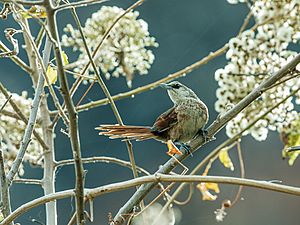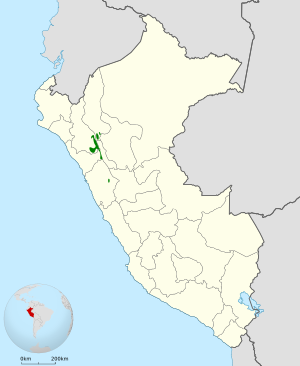Chestnut-backed thornbird facts for kids
Quick facts for kids Chestnut-backed thornbird |
|
|---|---|
 |
|
| Conservation status | |
| Scientific classification | |
| Genus: |
Phacellodomus
|
| Species: |
dorsalis
|
 |
|
The chestnut-backed thornbird (scientific name: Phacellodomus dorsalis) is a special type of bird that belongs to the Furnariidae family, also known as the ovenbird family. This bird is endemic to Peru, which means it is only found naturally in Peru and nowhere else in the world!
Its natural habitat is a type of shrubby vegetation, similar to the bushes and small trees you might find in places with warm, dry summers. Sadly, this bird is currently threatened because it is losing its home.
Contents
About the Chestnut-backed Thornbird
The chestnut-backed thornbird is a small to medium-sized bird. It gets its name from the reddish-brown (chestnut) color on its back. These birds are known for their unique nests, which are often large and complex, built from twigs and other plant materials. They are usually found in dry, bushy areas.
Where Does It Live?
This bird lives only in Peru, a country in South America. You can find it in specific regions where the climate is dry and there are plenty of shrubs and small trees. These areas provide the perfect environment for the thornbird to find food and build its nests.
Why Is It Threatened?
The biggest danger to the chestnut-backed thornbird is habitat loss. This happens when the places where the birds live are destroyed or changed. For example, land might be cleared for farming, buildings, or other human activities. When their habitat disappears, these birds lose their homes, their food sources, and safe places to raise their young. This makes it harder for them to survive and thrive.
What Can We Do?
Protecting the chestnut-backed thornbird means protecting its habitat. Efforts are being made to conserve the dry shrublands in Peru where these birds live. By understanding and caring for these unique birds and their homes, we can help ensure they continue to fly freely in the skies of Peru for many years to come.
See also
 In Spanish: Espinero dorsicastaño para niños
In Spanish: Espinero dorsicastaño para niños


